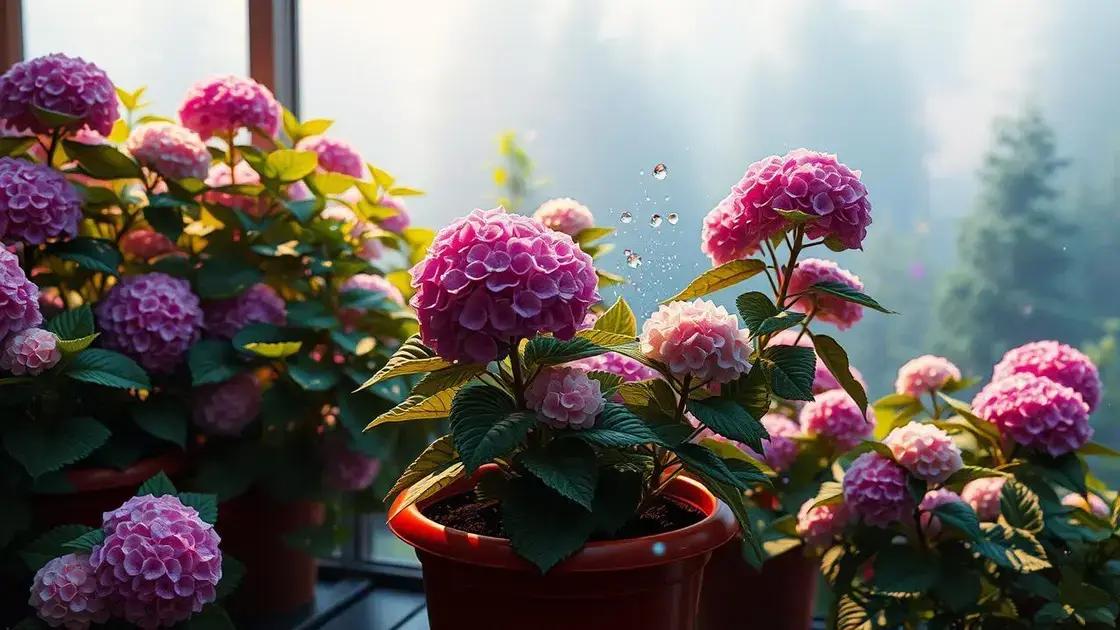How to care for a potted hydrangea plant is a question that many plant lovers ask. These beautiful blooms can brighten any home or garden, but do you know how to keep them thriving? With the right knowledge and care, you can ensure your hydrangeas flourish and produce stunning flowers year after year. Let’s dive into some essential care techniques that will transform your potted hydrangea into a vibrant centerpiece.
Table of Contents
ToggleUnderstanding hydrangea sunlight needs for optimal growth
Understanding hydrangea sunlight needs for optimal growth is crucial for keeping your potted hydrangea healthy and vibrant. These beautiful plants thrive in specific lighting conditions, and providing them with adequate sunlight can lead to stunning blooms. Here’s what you need to know about their sunlight requirements.
Hydrangeas generally prefer bright, indirect sunlight. Here’s a breakdown of their needs:
- **Morning Sun**: Hydrangeas benefit from the gentle morning sunlight, which helps them awaken and promotes healthy growth.
- **Afternoon Shade**: Too much direct sunlight in the afternoon can scorch their leaves, so providing some shade during this time is essential.
- **Location Considerations**: Placing them near a window that receives filtered light or in a partially shaded area is ideal.
To help you further, here’s a simple guide on how different types of hydrangeas react to sunlight:
| Type of Hydrangea | Sunlight Preference | Blooming Period |
|---|---|---|
| Bigleaf Hydrangea | Partial shade | Summer |
| Panicle Hydrangea | Full sun | Late summer |
| Oakleaf Hydrangea | Partial shade | Summer to fall |
To ensure your hydrangea reaches its fullest potential, monitor your plant’s condition and adjust its location as needed based on light availability.
Additionally, you can enhance your indoor gardening experience by exploring indoor gardening techniques that will further optimize your hydrangea care.
By understanding your potted hydrangea’s sunlight needs, you can achieve stunning growth and vibrant blooms.
Essential watering techniques for your potted hydrangea

Essential watering techniques for your potted hydrangea play a vital role in maintaining its health and bloom. Adequate watering ensures that your hydrangea receives the necessary moisture without the risk of overwatering. Here’s a comprehensive guide on how to effectively hydrate your potted hydrangea.
Understanding the watering needs of hydrangeas is key. Here are some essential techniques:
- **Use the right soil**: Ensure your potting mix retains moisture but also drains well to prevent root rot.
- **Check the moisture level**: Use your finger to test the soil’s moisture about an inch deep. Water when it’s dry.
- **Water evenly**: Make sure to water the plant evenly around the base to encourage even rooting.
- **Use room temperature water**: Cold water can shock the plant; use room temperature water for better absorption.
Here’s a simple guide to determine how often to water:
- **Daily monitoring**: During hot weather, hydrangeas may need daily watering.
- **Weekly check**: In moderate climates, check soil moisture once a week.
- **Adjust to season**: In winter, reduce watering frequency as the plant’s growth slows down.
If you want to improve your hydrangea care, considering the quality of water is also essential. Here are some tips:
| Type of Water | Benefits | Considerations |
|---|---|---|
| Tap Water | Readily available | May contain chemicals like chlorine |
| Rain Water | Natural and chemical-free | Requires collection and storage |
| Distilled Water | Free of minerals | Can be costly over time |
For more tips on enhancing your indoor gardening, consider exploring indoor gardening techniques that can work alongside your watering schedule. With these techniques, your hydrangea can thrive and produce beautiful flowers.
Best soil and fertilizing tips for healthy hydrangeas
Best soil and fertilizing tips for healthy hydrangeas are essential for promoting vibrant blooms and lush foliage. Choosing the right soil and fertilization practices can make all the difference in the health of your potted hydrangea.
Hydrangeas thrive in well-draining, nutrient-rich soil. Here are some tips on the best soil types for these beautiful plants:
- **Acidic to neutral pH**: Hydrangeas prefer soil with a pH between 5.5 and 6.5. You can test your soil’s pH level and amend it if necessary.
- **Organic matter**: Incorporating compost or aged manure will improve moisture retention and provide essential nutrients.
- **Well-draining mix**: A combination of peat, bark, and perlite or vermiculite helps with aeration and drainage.
When it comes to fertilizing, following a schedule and using the right products is crucial. Here’s how to fertilize your hydrangeas effectively:
- **Choose a balanced fertilizer**: Look for a fertilizer with equal parts nitrogen, phosphorus, and potassium (e.g., a 10-10-10 mix).
- **Feed in spring**: Apply fertilizer in early spring as new growth begins. This encourages healthy foliage and blooms.
- **Supplement during growth**: A light feeding every 4-6 weeks during the growing season can boost flowering.
- **Avoid late fertilizing**: Do not fertilize in late summer or fall, as this can lead to weak growth that does not survive the winter.
Here’s a quick comparison of different types of fertilizers you can use:
| Fertilizer Type | Pros | Cons |
|---|---|---|
| Granular Fertilizers | Slow-release, easy application | Can be uneven if not applied properly |
| Liquid Fertilizers | Quick absorption, good for immediate nutrients | Requires more frequent application |
| Organic Fertilizers | Improves soil health over time | May take longer to show benefits |
To enhance your hydrangea care, you might also consider exploring indoor gardening techniques that complement your soil and fertilization strategy. Ensuring the right soil and proper fertilization will lead to the healthiest, most vibrant hydrangeas in your garden.
In conclusion
Caring for your potted hydrangea requires a blend of proper sunlight, watering techniques, and soil management. By understanding the unique needs of your hydrangea, you can ensure it thrives and flourishes with vibrant blooms. Remember to always monitor your plant’s conditions and adjust as necessary based on its growth environment. For more tips on enhancing your indoor garden, explore various resources to improve your gardening skills.

